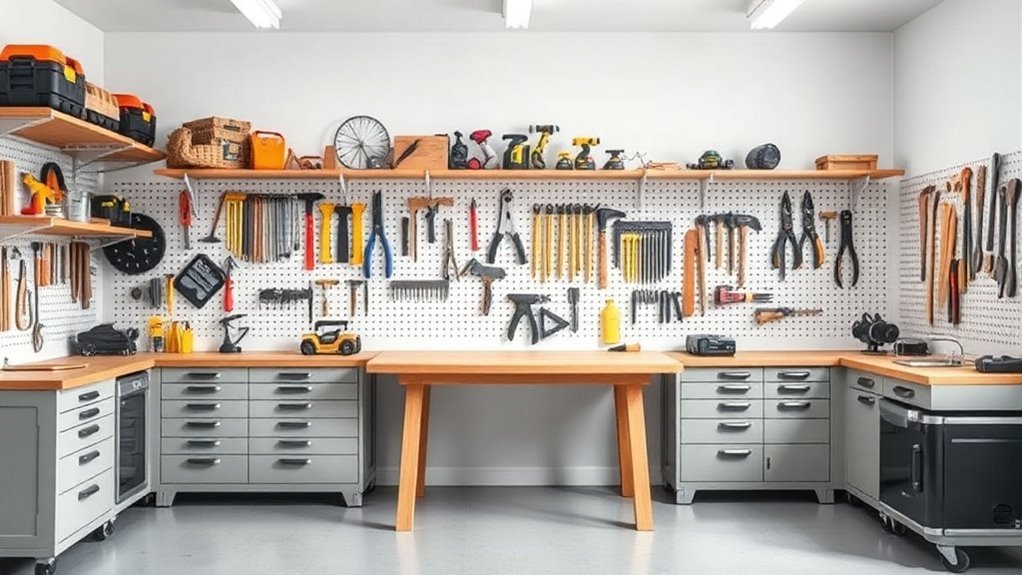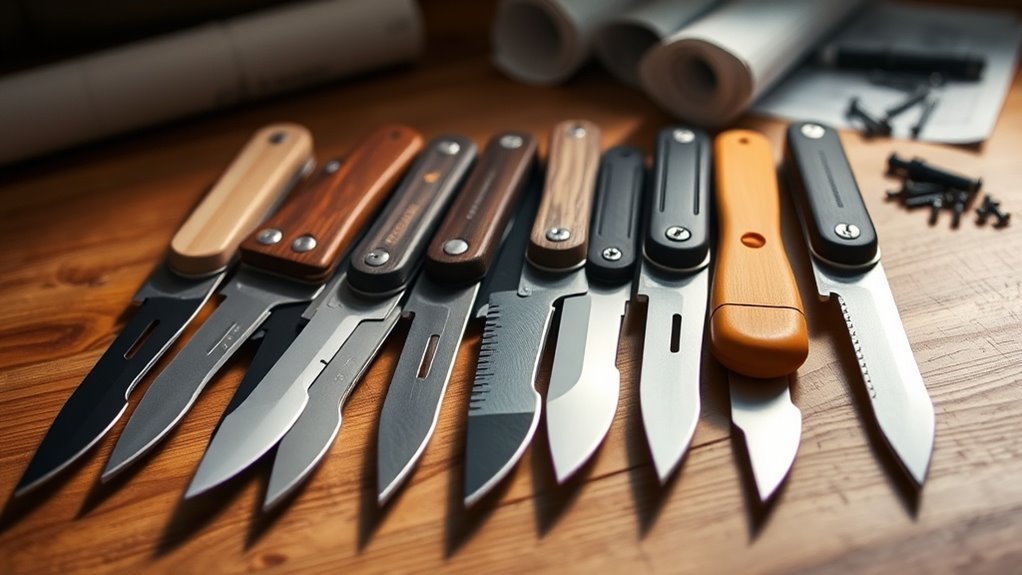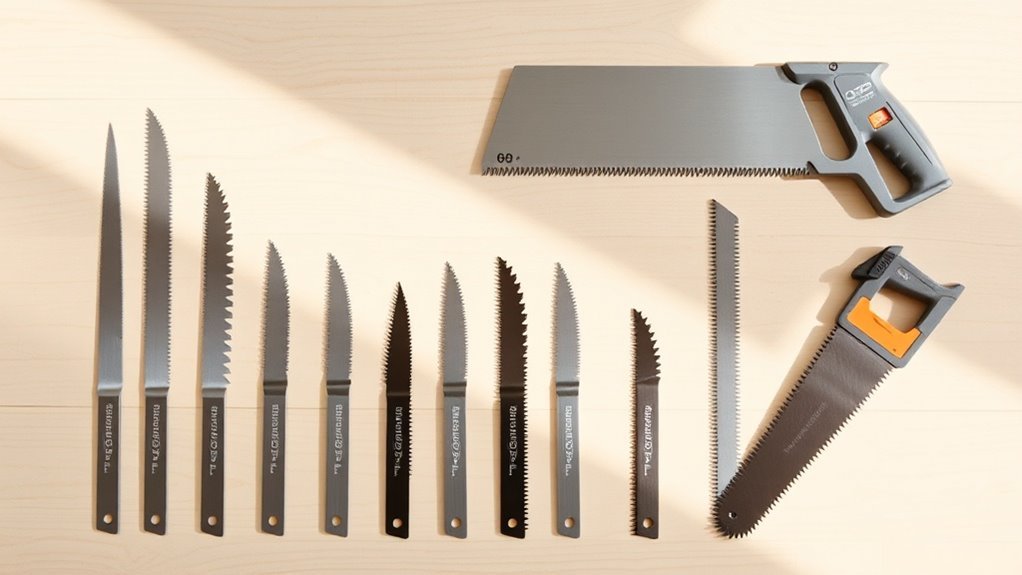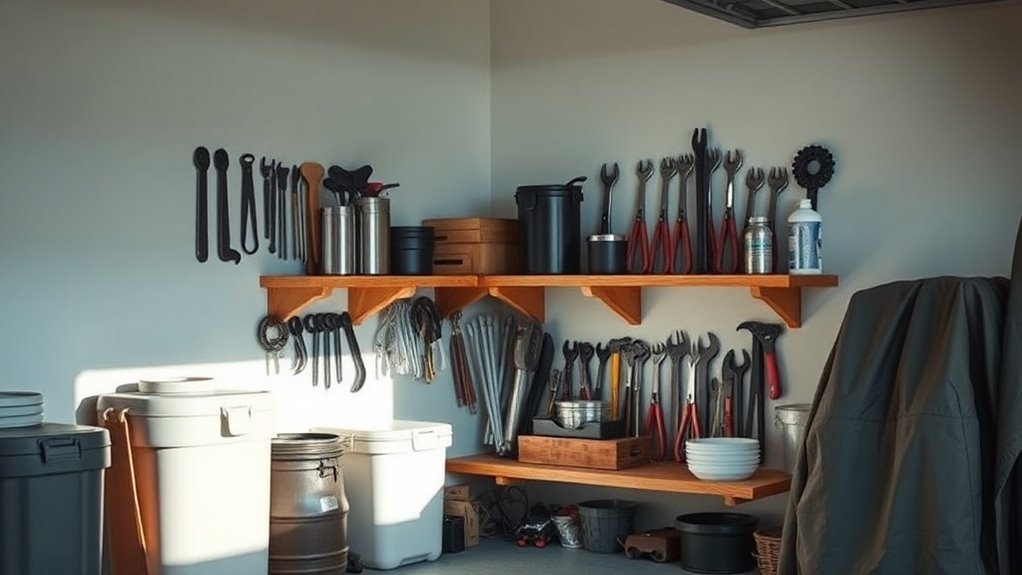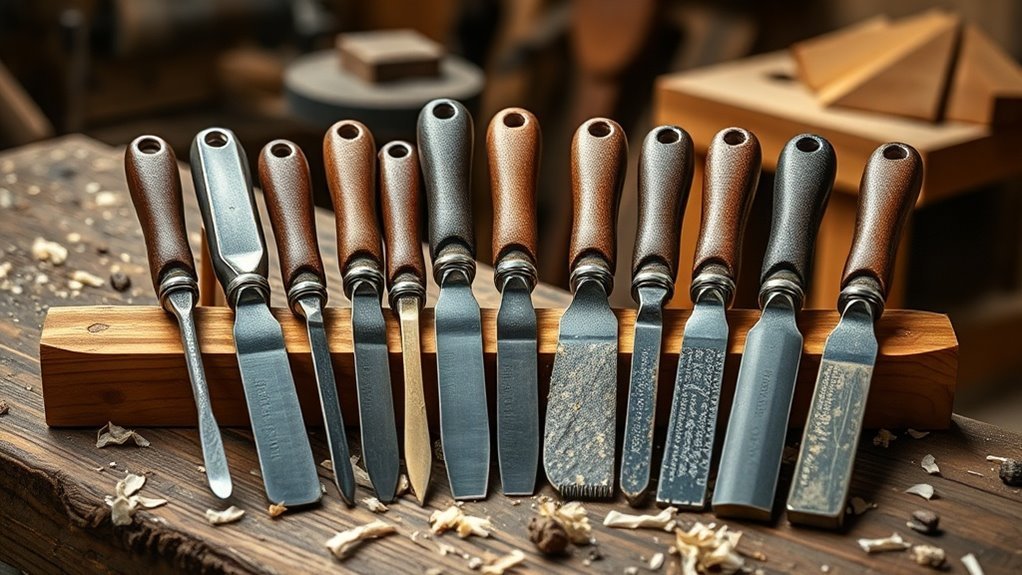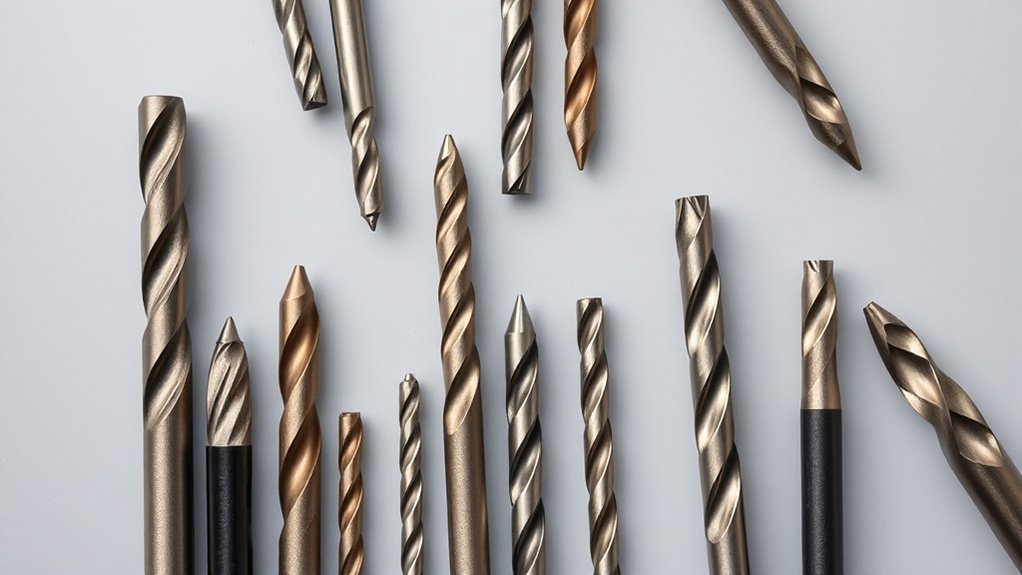How to Maintain and Sharpen Hand Tools
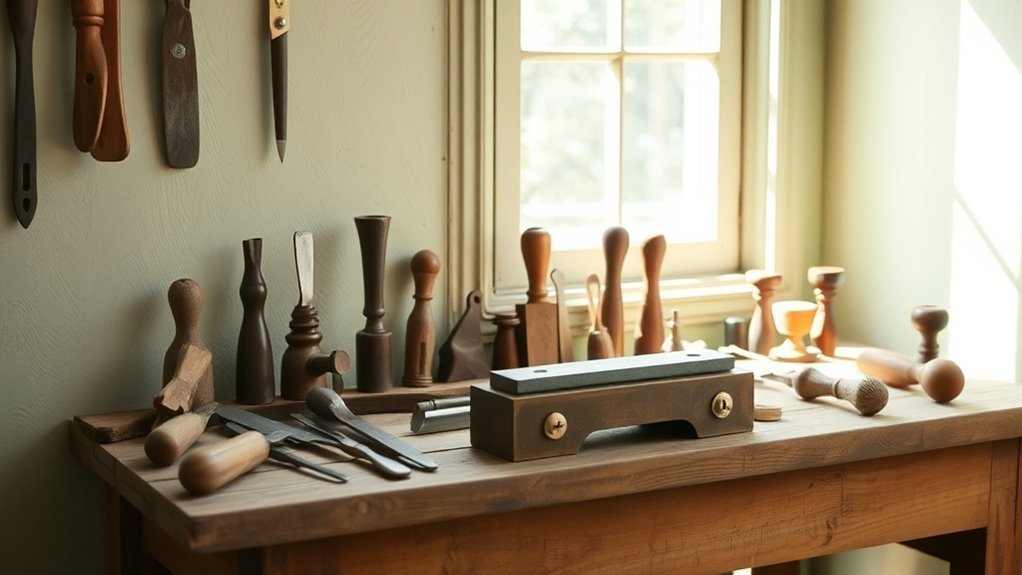
To maintain and sharpen your hand tools, you should clean them after each use to prevent rust. Regularly inspect for wear, lubricate moving parts, and sharpen cutting edges for efficiency and safety. For chisels, establish a 25-degree bevel angle when sharpening. Remember to wipe saw blades clean and inspect for damage. Proper care of tool handles can enhance comfort and control. If you’re curious about more detailed techniques and best practices, there’s plenty more to explore.
Key Takeaways
- Establish a routine for cleaning tools after each use to prevent rust and maintain functionality.
- Regularly inspect tools for wear and damage, addressing issues promptly to ensure safety and efficiency.
- Use appropriate sharpening tools and techniques, ensuring the correct angle for chisels and saws to maintain sharpness.
- Keep tool handles clean and treat with oil to protect against moisture and improve grip over time.
- Always wear protective gear when sharpening and maintain a clean workspace to avoid accidents.
Understanding the Importance of Tool Maintenance
Maintaining your hand tools isn’t just a matter of practicality; it’s a commitment to craftsmanship. When you take care of your tools, you’re investing in the quality of your work and ensuring they perform at their best.
Caring for your hand tools elevates your craftsmanship, ensuring exceptional performance and quality in every project.
Well-maintained tools not only last longer but also enhance precision and safety in your projects. Think about it: a dull blade or rusted surface can lead to mistakes and even accidents.
By dedicating time to regular upkeep, you cultivate a reliable toolbox that reflects your skills and dedication. Plus, there’s something satisfying about knowing your tools are in top shape, ready for any challenge. Additionally, regular sharpening of your tools is essential for optimal gardening performance and can significantly improve your work’s overall efficiency.
In the end, proper maintenance is as much about respect for your craft as it’s about functionality.
Common Hand Tools and Their Maintenance Needs
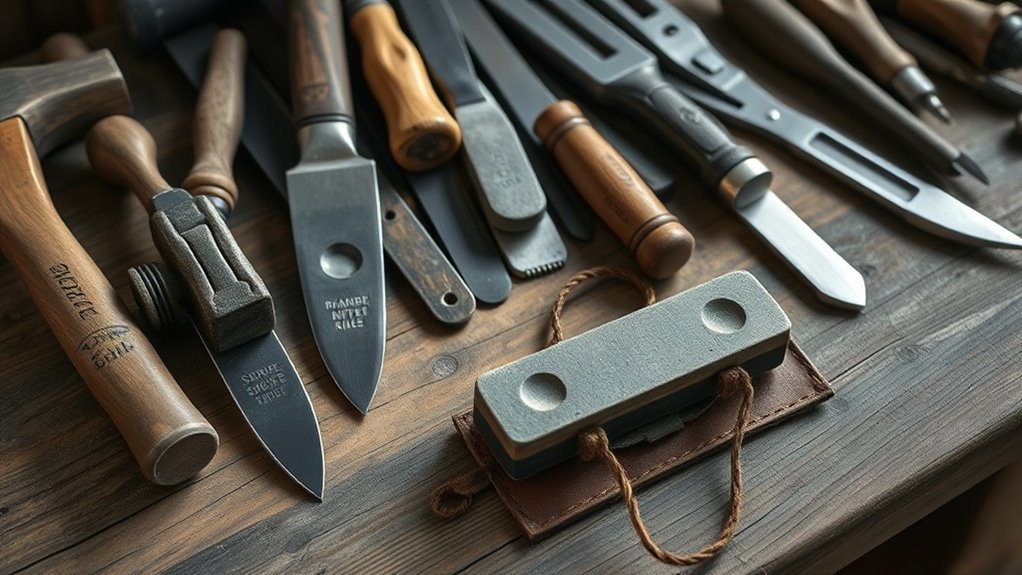
Hand tools are the backbone of any toolbox, and each type comes with its own set of maintenance requirements.
For example, pliers should be regularly cleaned and have their pivot points lubricated to secure smooth operation. Wrenches benefit from a light oil treatment to prevent rust and wear.
Keep screwdrivers sharp by honing their edges; a dull blade can slip, causing frustration.
Keep your saws in check by wiping the blades clean and applying some rust inhibitor.
Hammers just need a check for loose heads and a cleaning after use.
Finally, regularly inspect your measuring tools like tape measures to guarantee accuracy. Proper tool storage techniques are equally important to ensure longevity and safety when these tools are not in use.
Safety Precautions for Tool Sharpening
When it comes to keeping your tools sharp, safety shouldn’t be overlooked. Sharp tools can be dangerous if not handled properly. Always wear safety goggles to protect your eyes from flying debris and work gloves for grip. It’s vital to keep your workspace tidy to avoid tripping hazards. Remember to use tools designed for sharpening, and never force a dull blade. Following safety guidelines not only enhances safety but also improves efficiency when working with sharp tools.
| Safety Tip | Description | Importance |
|---|---|---|
| Wear Protective Gear | Goggles and gloves | Prevents injuries |
| Maintain Workspace | Clear clutter and debris | Reduces trip hazards |
| Use Proper Tools | Utilize correct sharpeners | Guarantees safe and effective sharpening |
| Focus on Your Task | Avoid distractions during work | Improves safety and attention |
| Secure Your Tools | Clamp or secure items being sharpened | Prevents slips and accidents |
Basic Tools for Sharpening Hand Tools
Sharpening tools effectively requires a few essential items to get the job done right.
First, you’ll need sharpening stones—these come in various grits to refine your edge. Wet stones and diamond stones are popular choices depending on your preference.
Next, a honing guide can help maintain the correct angle while sharpening, ensuring a consistent edge. You should also have a strop on hand, which is perfect for polishing the blade after sharpening.
Don’t forget a good quality lubricant, like honing oil or water, to reduce friction during the process.
Finally, a wire brush or some steel wool will help clean your tools, making the sharpening process smoother and more effective.
Keep these tools handy for ideal sharpening!
Step-by-Step Guide to Sharpening Chisels
Sharpening chisels might seem challenging, but with the right tools and techniques, you can master it easily.
We’ll walk you through selecting the appropriate sharpening tools, explain effective sharpening methods, and share tips for maintaining a sharp edge. Understanding the importance of hardness and toughness will help you choose chisels that perform better and last longer with just a little effort.
Choosing the Right Tools
While it might seem straightforward, choosing the right tools for sharpening chisels can considerably impact their performance and longevity.
Start by selecting a quality sharpening stone or honing guide that matches your chisels’ sizes. Many woodworkers prefer diamond stones for their durability and efficiency. You’ll also want a strop or polishing compound to refine the edge further.
Consider the grit of your sharpening tools; a coarse grit is useful for reshaping blunt edges, while finer grits are great for honing.
Don’t forget about protective gear—safety glasses are essential to keep your eyes safe during the process.
Finally, invest in a reliable measuring tool, like calipers, to check the sharpness and accuracy of your chisels throughout the sharpening process.
Sharpening Techniques Explained
Once you’ve selected the right tools for your chisels, it’s time to put them to use with effective sharpening techniques.
Start by securing your chisel in a vise to avoid slips. Next, choose a sharpening stone—wet or dry—and begin with the coarse grit to establish the bevel angle, typically around 25 degrees.
Push the blade across the stone in a sweeping motion, applying even pressure. After a few strokes, switch to a finer grit to refine the edge. Don’t forget to maintain the same angle throughout.
Once you’re satisfied, wipe the blade clean and check for a burr by running your finger along the edge.
Finally, a few strokes on a leather strop will give you that razor-sharp finish you desire.
Maintaining Edge Longevity
Maintaining the edge of your chisels is essential for achieving precision and efficiency in your woodworking projects. To prolong their sharpness, start by regularly honing the edges after each use. Use an appropriate honing guide to keep the angle consistent.
Next, clean the edge thoroughly to remove any resin or debris; this prevents dulling. When storing, protect the blade with a leather or wooden sheath to avoid accidental nicks. Avoid using chisels for prying or excessive force, as this can chip the edge.
Ultimately, periodically check the bevel angle and re-sharpen as needed. Following these steps will help you maintain edge longevity and guarantee your chisels perform at their best whenever you need them.
Techniques for Sharpening Plane Irons
Sharpening plane irons is essential for achieving clean, precise cuts in woodworking projects. To get the best results, use these techniques:
- Flatten the back: Start with a fine-grit stone or diamond plate to guarantee the back of the plane iron is perfectly flat. This helps in achieving a sharper edge.
- Set the bevel angle: Depending on your task, set the bevel angle between 25 to 30 degrees. Use a honing guide for consistent results.
- Hone with finer grits: Progress through finer grits, ending with a strop or polishing compound. This step refines the edge and enhances sharpness. Moreover, using hand tools allows for greater precision and control, which is particularly beneficial when sharpening and achieving optimal performance in your woodworking tasks.
Maintaining and Sharpening Saws
Keeping your saws in top shape is essential for smooth, efficient cutting. Regular cleaning helps prevent resin buildup and rust; wipe the blade with a rag and use a mild cleaner if necessary.
Inspect the teeth for damage, as dull or broken teeth can hinder performance.
To sharpen your saw, use a file or a dedicated saw sharpener. Focus on maintaining the original angle of the teeth, ensuring each is sharpened evenly.
Test your work by making a few cuts in scrap wood; you’ll notice the difference immediately.
Finally, store your saws properly, ideally hanging or in a protective case, to prevent any accidental damage.
With these practices, your saws will remain effective and last longer.
Caring for Scissors and Shears
When it comes to scissors and shears, keeping them in top shape is essential for smooth cutting.
You’ll want to start with regular cleaning to keep the blades free from debris and sticky residue.
After that, sharpening them properly can extend their life and improve their performance.
Cleaning Scissors and Shears
Although scissors and shears are essential tools in your kit, it’s easy to overlook their care. Keeping them clean not only guarantees peak performance but also prolongs their life.
Here are some quick tips to help you maintain these tools:
- Wipe blades with a cloth after each use to remove sticky residue and debris.
- Clean with mild soap and warm water if there’s significant buildup, then dry thoroughly to prevent rust.
- Lubricate the pivot point with a drop of oil occasionally to guarantee smooth operation.
Sharpening Techniques Overview
Regular sharpening is vital for maintaining the effectiveness of your scissors and shears. Start by inspecting the blades for any nicks or dull spots. You can use a sharpening stone or a specialized shear sharpener; just be certain to follow the original bevel angle.
If you’re using a sharpening stone, make smooth, even strokes along the blade’s length. For scissors, try using a pair of lightweight aluminum foil or sandpaper in between the blades as you cut. This can help hone the edges slightly.
After you’ve sharpened, wipe the blades clean and apply a drop of oil to keep them lubricated. Regular attention to sharpening will guarantee peak cutting performance and prolong the lifespan of your tools.
Keeping Your Tool Handles in Good Condition
To keep your tool handles in good condition, it’s essential to take a few simple steps that can extend their lifespan and enhance your grip. Regular maintenance doesn’t only prevent wear and tear; it also guarantees that you stay safe while working.
Here are a few tips you should follow:
- Clean handles regularly: Use a damp cloth to remove dirt and sweat that can corrode the material.
- Sand rough areas: If you notice splinters or rough patches, lightly sand them down to improve comfort and control.
- Apply a protective finish: Consider using linseed oil or a specialized wood treatment to help preserve the finish and prevent moisture absorption.
Additionally, storing your tools in a dry, cool environment will protect them from humidity and extreme temperatures, contributing to their longevity. Implementing these practices will keep your tools in peak condition and ready for any task.
Best Practices for Regular Tool Maintenance
Keeping your tools in top shape requires a commitment to regular maintenance. First, set up a routine to clean your tools after each use. Removing dirt and moisture prevents rust and prolongs lifespan.
Next, inspect them regularly for wear or damage, addressing any issues before they worsen. Lubricate moving parts to guarantee smooth operation, and remember to sharpen cutting edges as needed—sharp tools work better and are safer to use.
Regularly check for wear and damage, lubricate parts, and sharpen edges to ensure tools are efficient and safe.
It’s also essential to store your tools properly; keep them in a dry, organized space.
Finally, maintain a log of inspections and maintenance tasks to track your tool care over time. Following these practices will guarantee your hand tools stay efficient and reliable for years to come.
Questions
How Often Should I Sharpen My Hand Tools?
You should sharpen your hand tools regularly, ideally after every few uses or when you notice a decrease in performance. Keeping a consistent sharpening schedule will enhance their effectiveness and prolong their lifespan.
Can I Sharpen Tools Without Power Equipment?
Yes, you can sharpen tools without power equipment. Using a handheld file, whetstone, or honing guide gives you control and precision. It’s often more satisfying, allowing you to truly connect with your tools.
What Materials Can I Use for Sharpening?
You can use honing stones, diamond plates, sharpening rods, or even specialized files for sharpening. Each material offers unique benefits, so choose based on your tool type and desired sharpness to achieve the best results.
Is Rust Prevention Necessary for Tool Maintenance?
Oh sure, let your tools rust away! Rust prevention’s just a fancy term for keeping your tools usable. Yes, it’s necessary. Regularly oiling them can save you a lot of headaches down the road.
How Do I Store Sharpened Tools Safely?
To store sharpened tools safely, keep them in a dry, secure place, ideally in a toolbox or on a pegboard. Use blade guards or sheaths to protect edges and prevent accidents when reaching for them.
Conclusion
By maintaining your hand tools, you’re not just preserving their performance; you’re enhancing your craftsmanship. By sharpening blades, you’re ensuring clean cuts that elevate your work. By caring for handles, you’re promoting comfort and safety while you create. Remember, regular maintenance pays off in longevity and efficiency, allowing you to tackle your projects with confidence. So, invest a little time today, and you’ll enjoy the fruits of your labor for years to come.

